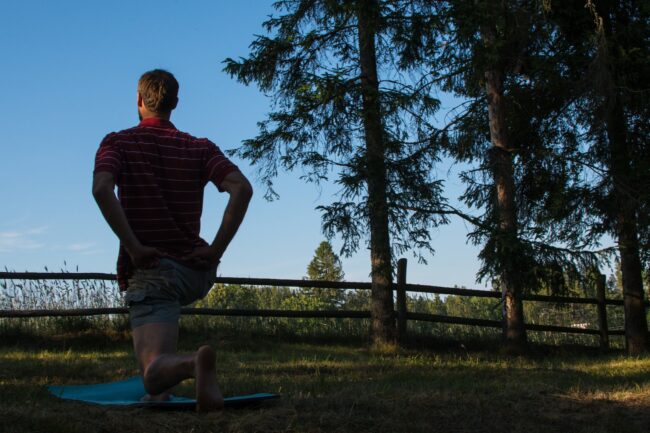Let’s be honest, How often have we all wrapped up a grueling workout session and thought, “I don’t really need to stretch, do I?” The answer is a resounding yes, you should. As it turns out, the few minutes you dedicate to stretching after your workout can make all the difference in your overall fitness journey. In this comprehensive guide, you’ll discover the optimal timing for stretching post-workout, the science-backed benefits, and practical advice on doing it right. So, let’s dive in.
Table Of Contents
−- Understand Your Muscles Inside and Out
- Unlock the Multitude of Stretching Benefits
- Don’t Skimp on the Warm-Up
- Master the Two Forms of Stretching
- Why Dynamic Stretching Deserves Your Attention
- Integrating Static Stretching into Your Routine
- Timing Matters: Know When to Stretch
- Mindful Breathing Elevates Your Stretching Game
- Practicing Patience: Stretching is a Marathon, not a Sprint
- Listen to Your Body: The Ultimate Stretching Guide
Understand Your Muscles Inside and Out
Before you even think about stretching, you should have a good grasp on which muscle groups you’ve engaged during your workout. For instance, if you’ve had a cardio-heavy day, your focus should be on stretching your quads, the muscles you use for running and walking. On the other hand, if it is a leg day involving lots of squats, your hamstrings are the muscles that will be crying out for some attention. This isn’t merely a ritual; it’s an informed strategy that allows you to zero in on the muscles that need recovery the most.

Unlock the Multitude of Stretching Benefits
The act of stretching does more than just alleviate immediate muscle soreness. It has a far-reaching impact on your physical well-being, including improving your flexibility, joint range of motion, and balance. This isn’t just good for your body; it’s excellent for your mind too. Stretching helps you wind down and can significantly lower your stress and tension levels. More scientifically, stretching encourages blood flow, promoting quicker recovery and setting your muscles up for next-level performance in your subsequent workouts.
Don’t Skimp on the Warm-Up
You may have just completed an intense workout, but warming up before stretching remains crucial. This is no time to cut corners. A well-executed warm-up transitions your body from a high-intensity state to one more conducive for stretching. Focus on dynamic exercises like leg swings or arm circles to elevate your body temperature and prepare your muscles for the stretches to come.
Master the Two Forms of Stretching
It’s crucial to differentiate between the two primary types of stretching: dynamic and static. Dynamic stretching involves constant movement, effectively prepping your muscles for the physical exertion ahead. Static stretching, on the other hand, is where you hold a position for an extended period to deepen the stretch. The former is perfect for warming up pre-workout, while the latter is the go-to method post-workout when your muscles are limber and warmed up.
Why Dynamic Stretching Deserves Your Attention
Even though you’re focusing on post-workout stretching, it’s essential to understand why dynamic stretching should be an integral part of your overall fitness strategy. This method helps elevate your heart rate and prepare your body for the main event, your workout. A proper dynamic stretching routine minimizes your risk of injury during the workout, ensuring that you get the most out of your fitness regimen.
Integrating Static Stretching into Your Routine
As you cool down post-workout, this is the time to incorporate static stretches targeting the muscles you’ve engaged. Aim to hold each stretch for a minimum of 30 seconds. Doing so enhances your flexibility and fosters a healthier range of motion. As you settle into the stretch, breathe deeply to help your body and mind relax, optimizing your stretching benefits.
Timing Matters: Know When to Stretch
The window for stretching effectively post-workout is a bit broader than you might think but aim to stretch within an hour after you’re done with your exercise. By then, your muscles are still warm, malleable, and best suited for stretching. And remember, stretching should never be painful; it should feel like a gentle extension of your capabilities.
Mindful Breathing Elevates Your Stretching Game
Your breathing pattern during stretching plays an essential role in maximizing its efficacy. Deep, conscious breathing helps you sink deeper into each stretch, facilitating muscle relaxation and tension release. Focusing on your breath also offers a meditative aspect that elevates your mental well-being.
Practicing Patience: Stretching is a Marathon, not a Sprint
Stretching is not something to rush through; it’s an investment in your future physical health. If you find yourself struggling to hold a stretch or battling fatigue, opt for shorter stretches, or consult a fitness expert. It’s essential to be gentle with yourself; your flexibility will naturally improve over time, with consistent and mindful practice.
Listen to Your Body: The Ultimate Stretching Guide
Finally, the most crucial advice when stretching is to listen to your body. If you experience any pain or discomfort, it’s a signal to ease up. Stretching should be challenging but never painful. If you encounter persistent issues, consult healthcare professionals for tailored advice.
Stretching may often be overlooked, but its benefits for recovery, performance, and well-being are undeniable. By incorporating mindful stretching into your post-workout routine, you not only elevate your current performance but set the stage for future success. So the next time you think about skipping that post-workout stretch, remember the many ways it can enhance your overall fitness journey.

Editorial Staff
Our writers, editors, content managers, and SEO specialist. We all take part in crafting amazing articles. We spend hours ensuring that each article is based on facts, researched, and thorough. You'll never want to click the back button to look for more answers other than here!
